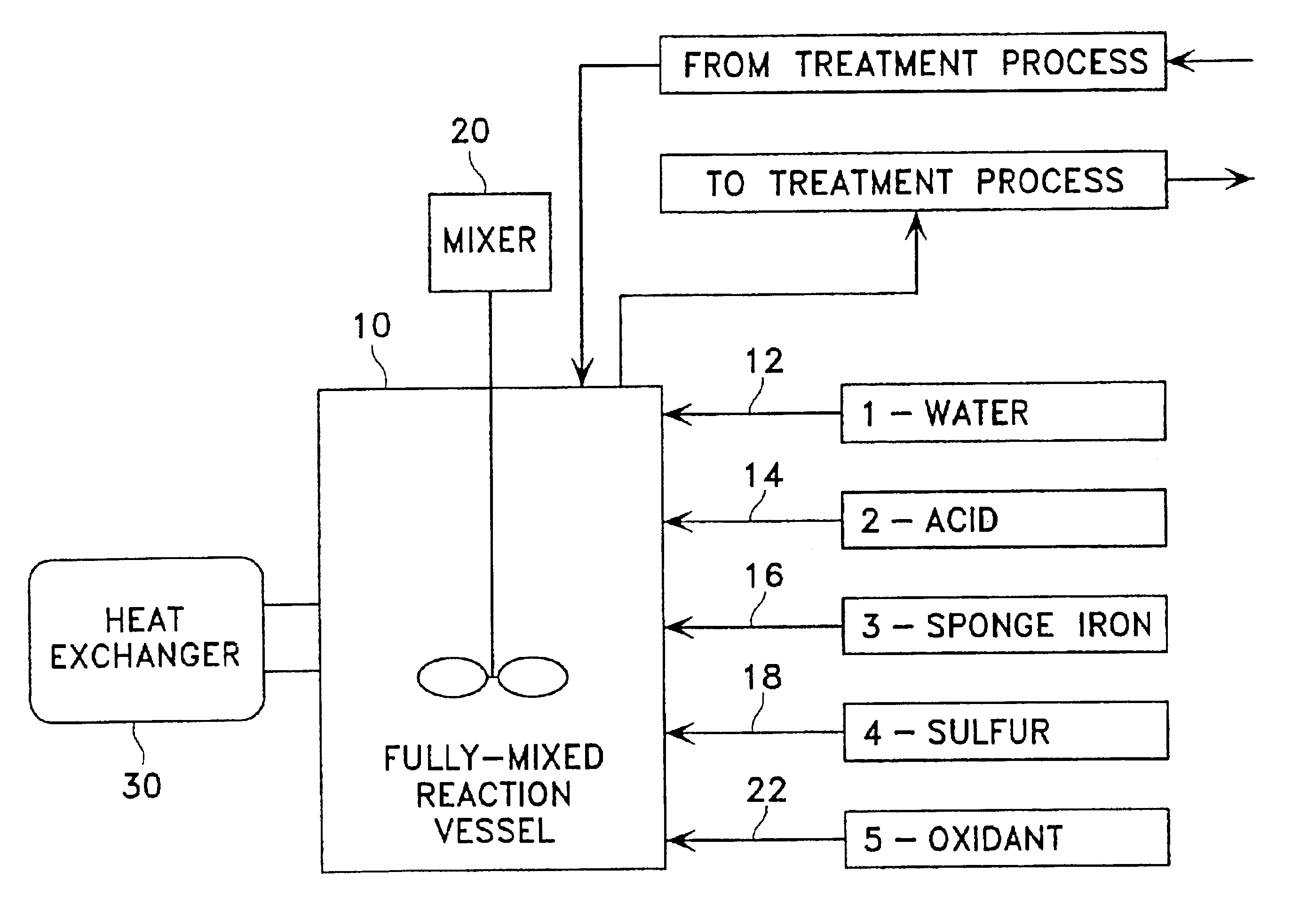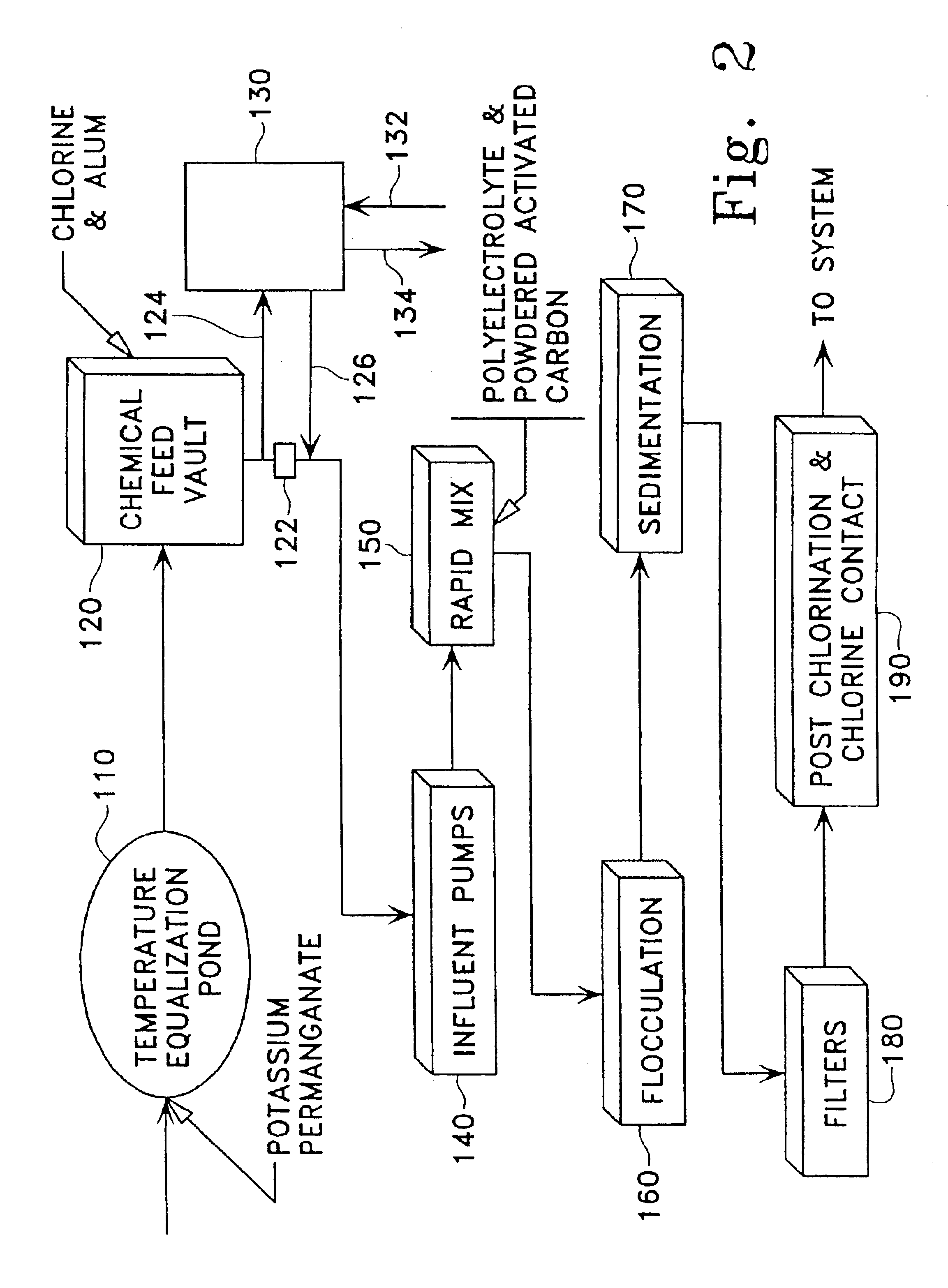Method for removing toxic substances in water
a toxic substance and water technology, applied in water softening, water/sewage treatment by oxidation, separation processes, etc., can solve the problems of uneconomical or ineffective current methods, systems and technologies, and inability to meet the proposed 2 g/l standard, and the epidemiological impact of dbps is uncertain
- Summary
- Abstract
- Description
- Claims
- Application Information
AI Technical Summary
Benefits of technology
Problems solved by technology
Method used
Image
Examples
example 1
Mar. 28, 1994
[0059]
TIMETEMPAs(min)ACTIVITYpH° F.LAB NOTES(μg / L)−30Refrigerated Kern Water Bank well8.834Clear, stirring slowly170water in unopened 1 L samplebottle. Well 32N2−15Add 3 mL 1 N H2SO44.360Clear, stirring slowly−10Add 0.3 g Fe, Grade B4.1Clear, stirring slowly0Add 0.1 g S, dry, powderedCloudy, stirringslowly0Increase stirring to rapidCloudy, rapid+206.1Cloudy, rapid+20Add 1 drop 3% H2O25.5Cloudy, rapid+112Decant and sample. Laboratory6.4Cloudy (beforeNDfilter.filtration)ND = Not detected. Practical Quantitation Limit = 5 μg / L.
EXAMPLE 2
Arsenic in Well Water
[0060]Example 2 uses the same sample water source and treatment dynamics as Example 1 and is a confirmation of the methods of Example 1. The reagent quantities and procedures varied lightly.
example 2
Apr. 4, 1994
[0061]
TIMETEMPAs(min)ACTIVITYpH° F.LAB NOTES(μg / L)−30Refrigerated Kern Water Bank well9.334Clear, stirring170water in unopened 1 L samplerapidlybottle. Well 32N2−10Add 3 mL 1N H2SO43.560Clear, stirringrapidly−5Add 0.2 g Fe, MH-1003.4Clear, stirring(slightly coarser than Grade B)rapidly0Add 0.1 g S, dry, powdered3.4Cloudy, stirringslowly+155.6Cloudy, rapidstirring+15Add 1 drop 3% H2O24.5Cloudy, rapid+161Decant, filter, & sample.5.8Cloudy (reddish)ND
EXAMPLE 3
Arsenic in Well Water
[0062]Example 3 uses the same sample water source and treatment dynamics as Examples 1 and 2. It is a confirmation of the methods of Examples 1 and 2, with slightly different reagent quantities and procedures, including acid and iron quantities. Note that initial pH in Examples 1-3 is 8.8 to 9.3, with essentially complete arsenic removal.
example 3
Apr. 13, 1994
[0063]
TIMETEMPAs(min)ACTIVITYpH° F.LAB NOTES(μg / L)−30Refrigerated Kern Water Bank well9.034Clear, stirring170water in unopened 1 L samplerapidlybottle. Well 32N2−10Add 1.5 mL 1N H2SO46.460Clear, stirringrapidly0Add 0.15 g Fe, MH-1006.0Clear, stirringrapidly0Add 0.1 g S, dry, powdered6.0Cloudy, stirringslowly+256.1Cloudy, rapid+15Add 1 drop 3% H2O25.7Cloudy, rapid+170Decant, filter, & sample.7.8CloudyND
EXAMPLE 4
Arsenic in Well Water
[0064]Example 4 uses the same sample water source and treatment dynamics as Examples 1, 2, and 3, except that sulfur is not added (except as present in sulfuric acid). It is a confirmation of the methods of the previous examples, but indicating that arsenic removal is not as complete without addition of sulfur.
PUM
| Property | Measurement | Unit |
|---|---|---|
| Temperature | aaaaa | aaaaa |
| Temperature | aaaaa | aaaaa |
| Temperature | aaaaa | aaaaa |
Abstract
Description
Claims
Application Information
 Login to View More
Login to View More - R&D
- Intellectual Property
- Life Sciences
- Materials
- Tech Scout
- Unparalleled Data Quality
- Higher Quality Content
- 60% Fewer Hallucinations
Browse by: Latest US Patents, China's latest patents, Technical Efficacy Thesaurus, Application Domain, Technology Topic, Popular Technical Reports.
© 2025 PatSnap. All rights reserved.Legal|Privacy policy|Modern Slavery Act Transparency Statement|Sitemap|About US| Contact US: help@patsnap.com



